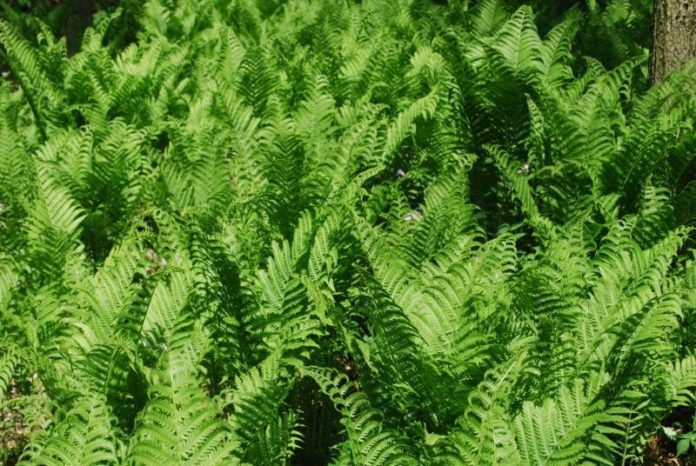By Larry Cornelis – President, Sydenham Field Naturalists
I think green is a wonderful colour and the green of ferns is effective at creating a pleasant,
relaxing monochromatic environment, especially in a woodland setting.
Time spent in such a scenario is very therapeutic.
You can create such a space in your home landscape if you have some shade.
Ferns are amazingly effective at providing form and texture in the garden/landscape.
Native ferns come in different hues of green; dark green, medium green, yellow green, emerald green, blue green etc.

Some have good fall colours too. Their foliage is a contrast bonus in the woodland garden, matching nicely with the straight lines of grasses, and sedges.
Beak grass and plantain-leaved sedge are great fern companions that are shade tolerant.
Mosses are great partners too.
There are over 25 species of ferns native to our area.
Some of these are very rare and a few are listed as ‘Species at Risk’.
About half of them are common.
Ferns are among the oldest living organisms on earth existing for over 300 million years.
They have no need for pollinators, hence no showy flowers to attract them.
They produce spores on the female part of the plant (fertile frond) or on a fertile stalk, which grows in the middle of sterile fronds.
Ferns come in very interesting forms, shapes and sizes and range in size from small 5″ specimens (grape fern) to large 40″ plants (ostrich fern).
The fertile stalks of some species, like cinnamon fern and sensitive fern are remarkably interesting and showy.
Ferns are not bothered by insects much.
Very few Lepidoptera larvae can use ferns as host plants.
Naturally, most of them require plenty of shade and moisture but some (Christmas fern) can tolerate dry soil and many (bracken fern, sensitive fern) can tolerate full sun if they have consistent moisture.
Basically, I recommend ferns for the woodland garden.
There are clump forming species (spinulose wood fern, lady fern, cinnamon fern, Christmas fern) and spreaders (marsh fern, ostrich fern, New York fern, bracken) that grow as large drifts and ground covers.
I like to use both in the garden design, mimicking the natural woods.
Provide shade, moisture and humus rich soil and most are easy to grow.
Most garden centres sell a variety of native ferns.
Give them a try in your garden.
The Sydenham Field Naturalists will have some available at the Native Plant sale next May 2021.
Following is a list of ferns I recommend for the woodland garden:
– Bracken Fern (Pteridium aquilinum)
– Bulblet Fern (Cystopteris bulbifera)
– Cinnamon Fern (Osmunda cinnamomea)
– Christmas Fern (Polystichum acrostichoides)
– Interrupted Fern (Osmunda claytonia)
– Maidenhair Fern (Adiantum pedatum)
– Marsh Fern (Thelypteris palustris)
– New York Fern (Thelypteris noveboracensis)
– Northern Lady Fern (Athyrium filix-femina)
– Ostrich Fern (Matteuccia struthiopteris)
– Royal Fern (Osmunda regalis)
– Sensitive Fern (Onoclea sensibilis)
– Spinulose Wood Fern (Dryopteris carthusiana)
For more details, visit: sydenhamfieldnaturalists.ca
















